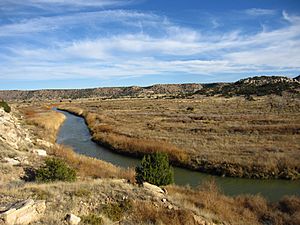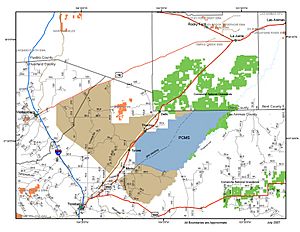La Placita, Colorado facts for kids
Quick facts for kids
La Placita
|
|
|---|---|
|
Settlement
|
|

The Purgatoire River Valley
|
|
| Etymology: Small plaza (New Mexico Spanish) | |
| Country | United States |
| State | Colorado |
La Placita was a small community in southeastern Colorado that existed around the 1890s. Its name means "small plaza" in New Mexican Spanish. This historic settlement was located in the Purgatoire River Valley, south of La Junta and east of Trinidad. Today, its remains are found on the Piñon Canyon Maneuver Site (PCMS).
Contents
History of La Placita
Hispanic families began settling the Purgatoire River Valley in the late 1860s. The Cordova family from Taos, New Mexico, built a strong, protected plaza. Soon, other small communities started to form. By 1874, about 450 people lived in the area. Like many frontier settlements, there were more men than women.
In the 1880s, large ranches started to combine and grow. They often used public land for their animals. A British company, Prairie Cattle Company, bought over 2 million acres south of the Arkansas River. This meant that people from other places, often called "Anglo" settlers, moved into lands traditionally used by Mexicano and Hispanic families. This changed the area a lot.
After the Mexican American War, citizenship and statehood became important. By the time La Placita was founded around 1890, more settlers from other states lived in Colorado than the original New Mexican settlers.
La Placita was settled around 1890 and was used for about ten years. It was abandoned by 1898. The people of La Placita never legally owned the land. However, they built very strong and well-planned homes. This was a common way for Mexicano groups to settle. They would first work the land to see if it was good before trying to officially own it.
La Placita was likely abandoned because the Mexicano population became spread out. As people moved to new areas, they became more distant from each other. This made it hard to get important things like help from midwives, healers, or churches. This lack of a close community probably led people to leave places that were far from towns.
Environment Around La Placita
La Placita is located along the Purgatoire River. This river starts in Colorado's Sangre de Cristo Mountains. It flows until it joins the Arkansas River. The area around the river has mesas (flat-topped hills), rocky cliffs, arroyos (dry creek beds), and canyons. The Purgatoire River is often the main water source during dry times.
The region is very dry, or arid. It gets only about 12 inches of rain each year. In winter, the average temperature is around 30 degrees Fahrenheit. In summer, it averages 90 degrees Fahrenheit. The area has many grasslands, juniper trees, shrubs, and cacti. You can find animals like mountain lions, bobcats, antelope, bears, raccoons, mice, rats, and many types of birds.
La Placita was built between two canyons, Welsh and Red Rock. It is part of the lower Dakota Formation. The settlement was carefully placed on a flat area, or terrace. This terrace was below the open prairie but above the canyon. This spot protected the homes from cold winter winds. It also allowed cool summer breezes when temperatures could reach 110 degrees Fahrenheit.
Archaeology at La Placita
Discovering the Site
In the early 1980s, the U.S. Army bought land to create the PCMS. They hired archaeologists to study the history of the area. From 1983 onward, archaeologists and architectural historians explored the PCMS many times.
In 1993, a survey found fifty sites with old buildings and artifacts on the surface. Site 5LA6104, which was later named "La Placita," was one of these important sites.
Studying and Digging
The La Placita settlement had several homes made of stone. They were arranged in a crescent shape around an open area. These buildings sit below rock outcrops and above an arroyo that leads into Red Rock Canyon. Dr. Bonnie Clark, from the University of Denver, started studying the site in 2000.
Structures at La Placita
There are six main buildings at La Placita. They were built using local flat sandstone and mud mortar. The walls were about 2.5 meters (8 feet) high. The roofs were flat, but none of them remain today. The floors inside the buildings were made of packed earth, smoothed by daily use.
La Placita seems to have at least three rooms used as homes. There is one building with two rooms and two buildings with one room each. These sizes are typical for homes in that region.
On the east side of the site, there is a two-room building. It has a fogon, which is a fireplace, in the southeast corner of the original room. Archaeological excavation showed that this two-room building and another one-room building were connected by a zaguan. A zaguan is a covered walkway or breezeway. It was a common feature in Hispanic architecture and could be used as an outdoor work area.
The attached one-room building did not have a fireplace. Because of its nice stonework and similar buildings at other Hispanic sites, some think it might have been a capilla, or small chapel.
The one-room building on the west side was also likely used as a home. Even though it doesn't have a fireplace, it probably had a cast-iron stove in one corner. Pieces of a stove found nearby support this idea. A terraced area just outside the door was probably used to grow vegetables for the family.
La Placita also had features for livestock. These include a corral built against a rock face and a barn. One small building is thought to be a chicken coop. This is supported by eggshells and chicken bones found at the site. Animal remains suggest that sheep, goats, and cattle were all raised at La Placita.
A stone building built into the hillside was likely used for storing food. Similar storage rooms have been found at other Hispanic sites. The one at La Placita seems to be a soterrano. This type of storage uses the natural coolness of the hillside to keep perishable foods safe.
Other Features
La Placita also had a horno, which is a "beehive-shaped outdoor oven." This type of oven was common in Nuevomexicano communities. It would have been shared by several families.
The residents of La Placita had a reliable water source. It was located southwest of the buildings. They collected natural water that seeped through the rock. They built a rock wall around the seep to create a small pool where water would collect.
The Plaza
The plaza was a central part of almost every New Mexican settlement. It was also very important to La Placita. The plaza was a shared open space. It was like the plazas in the villages where La Placita's residents had lived before.
The plaza might have been used for watching children or entertaining guests. It was also a place for traditional activities. For the wider Hispanic community in the Purgatoire River area, the plaza was a gathering spot. People would come together for feasts and religious celebrations.
Life at La Placita
Each room at La Placita was like its own small home. It had a heating source, like a chimney or iron stove, a window, and a door. A typical family at La Placita might have included a married couple, their children, and other relatives. Based on the living spaces, it's thought that at least eighteen people lived at La Placita.
The people of La Placita sold livestock and sheep wool at market. However, the settlement was probably supported by men who worked at larger ranches nearby. The women cared for children, prepared food, and raised livestock. Things like clothing, an axe head, and nails found at La Placita show that the residents bought goods from the market. This means they were part of the larger economy.
Why La Placita is Important
La Placita is an important archaeological site. It helps us understand what it was like to be Mexicano in Colorado at the end of the 1800s. It also shows how people carefully changed the land, even when they didn't legally own it. Finally, the short time La Placita was occupied helps us see how populations shifted. This happened as more Anglo settlers moved into traditional Mexicano lands after the Mexican American War.


